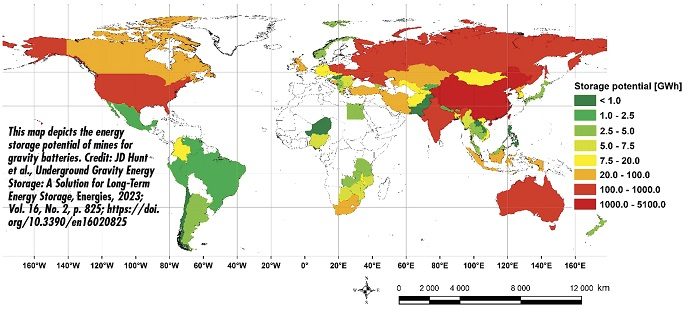A Theory of Gravity
How gravity batteries could aid the electrification movement

This map depicts the energy storage potential of mines for gravity batteries. Credit: JD Hunt et al., Underground Gravity Energy Storage: A Solution for Long-Term Energy Storage, Energies, 2023; Vol. 16, No. 2, p. 825; https://doi.org/10.3390/en16020825.
In the middle of the last century, we had a golden hour to revolutionize global energy handling. The postwar boom period was characterized by exponential growth in the human population, fossil-fuel use, water use, food production, international communication, and the pace of land-use conversion. This boom period also marks the dawn of the so-called Anthropocene Epoch characterized as the period in which the collective activities of human beings began to substantially alter Earth’s surface, atmosphere, oceans, and systems of nutrient cycling. Regardless of one’s position, the fact remains we are transitioning away from fossil fuels while our energy demands outpace production, and it has put humanity in a tight spot.
The electrification movement has the potential to significantly impact the industrial motion industry in several ways, as industries seek to reduce their carbon footprint, increase energy efficiency, and adopt more sustainable practices. The movement could lead to advancements in energy storage solutions for motion systems, ensuring consistent and reliable operation.
As renewables like solar, wind, and hydropower expand global energy production worldwide, the energy from them isn’t available on-demand but must be stored during the lulls, so the energy is sufficiently available during peak times. This energy-storage problem has been untenable for scaling up renewables thus far, but one age-old technology could address this issue: the gravity battery.
Gravity batteries, also known as gravitational energy storage systems, provide a means of storing and releasing energy in a sustainable and efficient manner. These systems utilize the force of gravity to store potential energy and convert it back into electricity when needed. The kinetic energy invested into raising a mass becomes potential energy that will never dissipate. Here’s how gravity batteries could aid the electrification movement:
Energy Storage: Gravity batteries offer a way to store excess electricity generated from renewable sources.
Grid Balancing: Gravity batteries can provide a rapid response to fluctuations in demand by releasing stored energy into the grid during peak usage times.
Energy Shifting: Gravity batteries enable energy shifting from off-peak to peak hours.
Long-Duration Storage: Gravity batteries can potentially store energy for indefinite periods without appreciable degradation.
Environmental Impact: Gravity batteries typically use heavy objects that have minimal environmental impact compared to conventional batteries.
Scalability: Gravity batteries can be adapted to different energy storage needs from residential use to large-scale installations for grid-level energy storage.
Location Flexibility: Gravity batteries don’t have the same geographical limitations as some other storage technologies.
Energy Access: Gravity batteries can provide a decentralized energy storage solution that supports electrification efforts.
Reduction of Emission Peaks: Gravity batteries can help reduce the need to rely on fossil fuel-based power plants that are often used to meet high electricity demand quickly.
It’s estimated that there are millions of decommissioned mines across the globe. By using decommissioned mines with a vertical shaft as the infrastructure for gravity batteries, enormous amounts of energy storage can be achieved. The technology is estimated to have a global energy storage potential of 7–70 TWh (terawatt hours). The high end is enough to power the entire world for a day. With nondissipative energy storage, such as that offered by the gravity battery, we could truly have a robust, grid-management solution that is shocking only in its simplicity.




